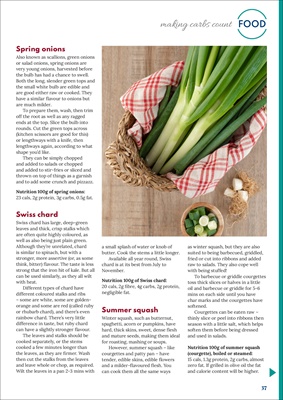
37
FOOD
making carbs count
Spring onions
Also known as scallions, green onions
or salad onions, spring onions are
very young onions, harvested before
the bulb has had a chance to swell.
Both the long, slender green tops and
the small white bulb are edible and
are good either raw or cooked. They
have a similar flavour to onions but
are much milder.
To prepare them, wash, then trim
off the root as well as any ragged
ends at the top. Slice the bulb into
rounds. Cut the green tops across
(kitchen scissors are good for this)
or lengthways with a knife, then
lengthways again, according to what
shape you'd like.
They can be simply chopped
and added to salads or chopped
and added to stir-fries or sliced and
thrown on top of things as a garnish
and to add some crunch and pizzazz.
Nutrition 100g of spring onions:
23 cals, 2g protein, 3g carbs, 0.5g fat.
Swiss chard
Swiss chard has large, deep-green
leaves and thick, crisp stalks which
are often quite highly coloured, as
well as also being just plain green.
Although they're unrelated, chard
is similar to spinach, but with a
stronger, more assertive (or, as some
think, bitter) flavour. The taste is less
strong that the iron hit of kale. But all
can be used similarly, as they all wilt
with heat.
Different types of chard have
different coloured stalks and ribs
- some are white, some are goldenorange
and some are red (called ruby
or rhubarb chard), and there's even
rainbow chard. There's very little
difference in taste, but ruby chard
can have a slightly stronger flavour.
The leaves and stalks should be
cooked separately, or the stems
cooked a few minutes longer than
the leaves, as they are firmer. Wash
then cut the stalks from the leaves
and leave whole or chop, as required.
Wilt the leaves in a pan 2-3 mins with
a small splash of water or knob of
butter. Cook the stems a little longer.
Available all year round, Swiss
chard is at its best from July to
November.
Nutrition 100g of Swiss chard:
20 cals, 2g fibre, 4g carbs, 2g protein,
negligible fat.
Summer squash
Winter squash, such as butternut,
spaghetti, acorn or pumpkins, have
hard, thick skins, sweet, dense flesh
and mature seeds, making them ideal
for roasting, mashing or soups.
However, summer squash - like
courgettes and patty pan - have
tender, edible skins, edible flowers
and a milder-flavoured flesh. You
can cook them all the same ways
as winter squash, but they are also
suited to being barbecued, griddled,
fried or cut into ribbons and added
raw to salads. They also cope well
with being stuffed!
To barbecue or griddle courgettes
toss thick slices or halves in a little
oil and barbecue or griddle for 5-6
mins on each side until you have
char marks and the courgettes have
softened.
Courgettes can be eaten raw -
thinly slice or peel into ribbons then
season with a little salt, which helps
soften them before being dressed
and used in salads.
Nutrition 100g of summer squash
(courgette), boiled or steamed:
15 cals, 1.3g protein, 2g carbs, almost
zero fat. If grilled in olive oil the fat
and calorie content will be higher.